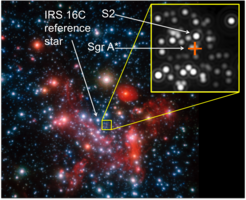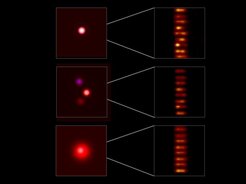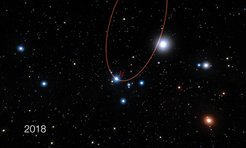The ideal black hole laboratory
Successful observations with GRAVITY and the ESO 8m Very Large Telescopes

Image of the galactic centre. For the interferometric GRAVITY observations the star IRS 16C was used as a reference star, the actual target was the star S2. The position of the centre, which harbours the (invisible) black hole with 4 million solar masses, is marked by the red cross.
Located a mere 25000 light-years from the Solar System, in the Sagittarius constellation, the centre of the Milky Way hosts a massive black hole, 4 million times as heavy as the Sun. Its position and mass are well known since 2002, when the first complete orbit of the star S2 was recorded: Over the course of nearly 16 years, the star draws a tiny ellipse with a size of only 0.2 arcseconds on the sky. A football stadium placed on the moon would appear as large – or small – when seen from Earth. While with previous instruments the astronomers could measure the orbit accurately enough to determine the mass of the black hole, testing general relativity requires pinpointing the object with centimetre precision in the imaginary stadium on the moon.
The new instrument GRAVITY – developed in a collaboration by the Max Planck Institute for Extraterrestrial Physics (MPE) and Astronomy (MPIA), LESIA of Paris Observatory and IPAG of Université Grenoble Alpes/CNRS, the University of Cologne, the Centro Multidisciplinar de Astrofísica Lisbon and Porto (SIM), and the European Southern Observatory (ESO) – is specifically designed for that purpose. It is an interferometer, i.e. it combines the light of the four 8-metre telescopes of the VLT on top of the mountain Paranal in the Chilean Atacama desert. To further improve GRAVITY's sensitivity in deeply embedded and dust enshrouded regions like the Galactic Centre, each of the 8-metre telescopes is also being equipped with a new Coudé Infrared Adaptive Optics (CIAO) system.

The images at the top show the unresolved star S2 and the data obtained with GRAVITY (interferometric fringes) next to it. The images below are for resolved stars: several sources (middle) and an extended source (bottom). In these cases, the fringes are increasingly blurred; this case can be excluded from the data.
Combining the light interferometrically yields an effective resolution equal to that of a virtual telescope as big as 130 metres. The corresponding gain of a factor 15 in resolving power and precision over the 8-meter telescopes will open up the possibility for testing Einstein's theory in the Galactic Centre. Having built this ultra-precise machine over the course of the past decade, the team now faced two crucial questions: Will GRAVITY provide the required sensitivity for observing the faint stars orbiting the Galactic Centre? And would the Galactic Centre laboratory collaborate and offer clean “test particles” to accurately measure the effects predicted by Einstein’s theory of general relativity?
"It was a fantastic moment for the whole team when the light of the fast-orbiting star S2 interfered for the first time", says GRAVITY lead scientist Frank Eisenhauer from the Max-Planck-Institute for Extraterrestrial Physics in Garching, Germany. "First we actively stabilized the interference on a bright nearby star, and only a few minutes later we could really see the interference from the faint star S2 – to a lot of high-fives.” On first glance neither the reference star nor the orbiting star have bright and massive companions, which would complicate the observations and analysis. "They are ideal probes", explains Eisenhauer.

But it was not only a technical challenge, but also a race against time: The rush for the GRAVITY observations is necessary because the star will pass closest to the black hole in 2018, where the sought-for relativistic effects are most pronounced. At this point the star will approach the black hole to a distance of only 17 light-hours, and will move at a speed of almost 8000 km/s, or 2.5% of the speed of light. That is a thousand times faster than the international space station ISS is orbiting Earth. In 2018, the S2 ellipse will change its orientation due to general relativity and will rotate in its plane by around 0.2°. This is orders of magnitude more than the relativistic effect affecting the orbit of Mercury, the Solar System’s innermost planet. The next opportunity after 2018 to observe the close passage of S2 around the black hole will only be in 2033.
Exciting times are ahead for black hole researchers!
Inside GRAVITY
Contact information:
Max Planck Institute for Extraterrestrial Physics, Garching, Germany
Press contact:
Hannelore Hämmerle
+49 (89) 30 000 3980
Scientific Contact:
Frank Eisenhauer
+49 (89) 30 000 3563
Laboratoire d'Études Spatiales et d’Instrumentation en Astrophysique
(LESIA, Observatoire de Paris, PSL Research University, CNRS, Sorbonne Universités, UPMC Univ. Paris 06, Univ. Paris Diderot, Sorbonne Paris Cité)
Paris, France
Press contact Paris Observatory:
Frédérique Auffret
+33 (0) 1 40 51 20 29
+33 (0) 6 22 70 16 44
Press contact CNRS/INSU:
Géraldine GONDINET
geraldine.gondinet@cnrs-dir.fr
+33 (0) 1 44 96 43 36
Scientific contact:
Guy Perrin
IPAG of Université Grenoble Alpes/CNRS, France
Press contact IPAG:
Natacha Cauchies
communication.osug@ujf-grenoble.fr
+33 (0) 4 76 63 55 11
Press contact CNRS/INSU:
Géraldine GONDINET
geraldine.gondinet@cnrs-dir.fr
+33 (0) 1 44 96 43 36
Scientific contact:
Karine Perraut
karine.perraut@univ-grenoble-alpes.fr
Max Planck Institute for Astronomy, Heidelberg, Germany
Press contact:
Markus Pössel
+49 (6221) 528 261
Scientific contact:
Wolfgang Brandner
+49 (6221) 528 289
University of Cologne – 1. Physikalisches Institut, Köln, Germany
Andreas Eckart
+49 (221) 470 3546
Centro Multidisciplinar de Astrofísica Lisbon and Porto (SIM), Lisbon, Portugal
Press contact:
Margarida Serote
+351 964951692
eson-portugal@eso.org
Scientific Contact:
António Amorim
+351 969897315
ESO, Garching, Germany
Scientific contact:
Markus Schöller
mschoell@eso.org
Press contact:
Richard Hook
+49 (89) 3200 6655
rhook@eso.org














